International SEO In The Times Of AI
Boost your skills with Growth Memo’s weekly expert insights. Subscribe for free!
How does AI change the translation game?
We have to acknowledge that AI revolutionizes international expansion.
It can localize content and creative at scale, with low cost and high fidelity.
For example, AI tools can identify local synonyms, slang, or spelling variations that match native search queries. Companies can create custom translation models tailored to their existing content, brand, voice, and tone.
A great example is Reddit, which has been using AI to translate content into other countries.
From Reddit Masterclass:
We can actually translate the existing Reddit corpus into other languages at human quality. Now, not all the content is relevant, but a lot of it is. We have been testing this in France, in French, in the first half of this year, and it’s gone very, very well.
It’s going well, indeed. As you can see in the screenshot below, Reddit is growing rapidly in many markets around the world.
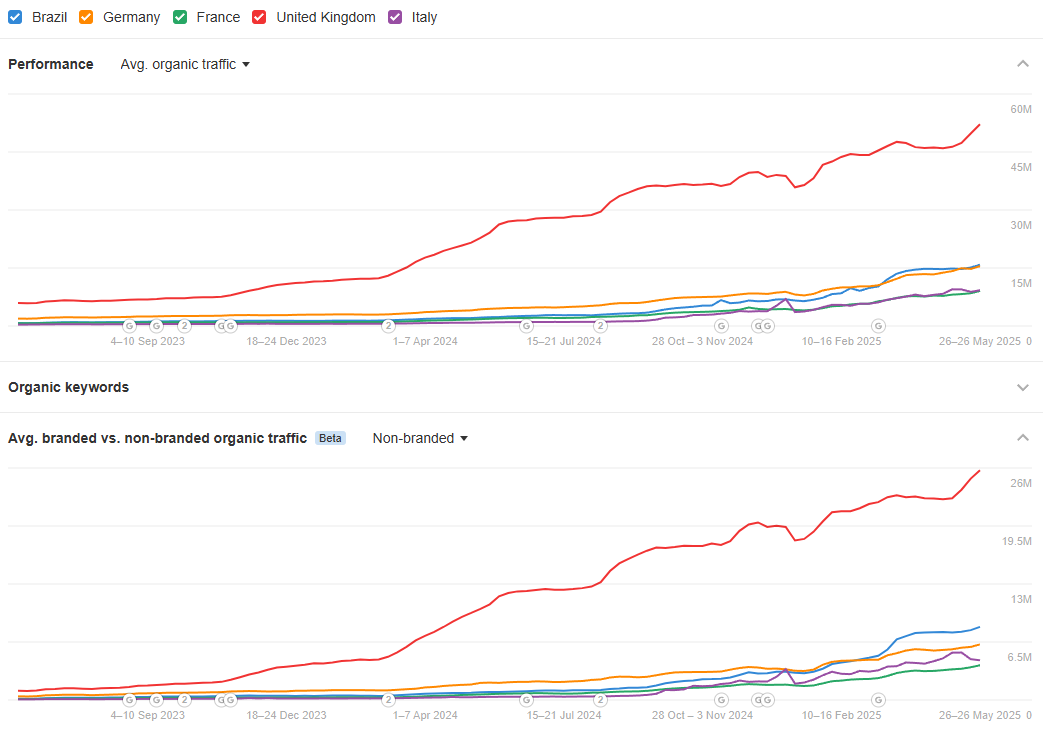 Image Credit: Kevin Indig
Image Credit: Kevin IndigThe purpose of localization is to create more “starter content” that inspires users in other countries to sign up and post on Reddit, which, in return, creates content that inspires more users to do the same.
Appearing in international search results is important to get that flywheel going.
The Reddit example shows that AI has become good enough for large-scale localization.
Another example is Airbnb, which has been using AI/ML to translate listing descriptions and reviews in over 60 languages:
As cross border travel returns, Airbnb’s new Translation Engine will provide a seamless experience for our Hosts and guests in over 60 languages. Translation Engine removes the need for click to translate buttons by automatically translating listing descriptions and reviews. Based on results from a study across our top ten languages we commissioned by a top machine translation evaluation company, Translation Engine improves the quality of more than 99% of Airbnb listings. Translation Engine uses millions of Airbnb data points to improve translations, so it will get even smarter over time as it learns from new content that’s submitted.1
Ultimately, if you are starting or growing your international SEO program, you should consider using these tools, especially if you want to avoid the most missed traps of internationalization that many marketing teams overlook.
And yet, I want to caution against not leaving humans out of the loop. Mistakes can, and will, happen. So, add a human QA step to the end of the localization pipeline.
Many teams stumble on the same two hidden traps when it comes to international SEO:
- Overlocalization of pages, resulting in duplicate content.
- Conflating translation with localization, leading to cultural mismatches.
Below, I’ll show you how to dodge these pitfalls for smoother, smarter global growth.
The Problem
Expanding global web presence often results in too many duplicated or minimally localized country-specific websites.
The result?
Split domain authority, duplicate content issues, confused search engines, and diluted user engagement. Not good.
Part of the problem is creating multiple localized site versions that are language-identical or very similar (e.g., separate sites for U.S. English, U.K. English, AU English, CA English, IN English, and so on).
While the intention makes practical sense, the end result often spells disaster for SEO. Multiple English-language URLs containing almost identical content quickly trigger potential duplicate-content issues.
Why It Matters
- Weakened link authority: Splitting your SEO equity across too many domains hurts overall rankings.
- Operational complexity: More sites mean more headaches keeping everything up-to-date, resulting in costly management overhead.
- Duplicate content: When several URLs carry near-identical text, Google’s algorithms struggle to decide which localized URL variant to serve, and the wrong variants frequently rank.
- Damaged user experience: Visitors arrive at pages that appear irrelevant or poorly targeted to their locale, viewing incorrect prices, availability, promotions, or contact details. The mismatch creates immediate friction and aggravates users.
- Conversion degradation: Localization promise falls apart when users see localized SERP snippets yet encounter mismatched in-site product details. Trust drops radically, abandonments spike, and conversion rates plummet.
- Wasted crawl budget and diluted authority: Handling multiple minimally differentiated URL sets spreads the domain’s backlink equity and crawl budget thinly. This reduces overall visibility and SEO performance across regions.
How To Solve It Clearly
- Consolidate languages into subdirectories ([yoursite.com/fr/, yoursite.com/de/ …]).
- One language, one subdirectory.
- Personalize for local details like currencies.
- Establish a global base for English under the root domain.
- Use a single canonical set of globally unified English-language pages as a baseline, usually serving from yoursite.com/.
- Use locale-specific modules.
- Customize relevant on-page details dynamically according to user location. Rather than building separate carbon-copy pages to handle minor variations like currency, tax displays, date formats, small spelling adjustments, or promotional discounts, use IP-based or user settings-based server-side modules.
- For example, implement a module that reads the IP location and loads the appropriate currency symbol and number format immediately. This minimizes duplicate issues drastically.
- Raise the threshold for launching new locales.
- Confirm clear need (traffic and economic feasibility).
- Verify team and budget readiness upfront.
- Don’t launch partially localized content – use “noindex” temporarily if needed.
- Segment only when truly necessary (and do it carefully).
- Split distinct URLs only when significant geographic differences lead you to create truly differentiated content. A few examples:
- Pricing drastically changes due to market structure or legal considerations.
- Products or SKUs’ availability heavily varies.
- Messaging must accommodate drastically different promotional considerations, regulations, or cultural sensitivities.
- Clearly document and sanity-check this rule: If the actual differences simply aren’t substantially meaningful from the user’s viewpoint, keep everything consolidated onto one unified English variant.
- Split distinct URLs only when significant geographic differences lead you to create truly differentiated content. A few examples:
- Monitor rigorously.
- Set up Google Search Console accounts per market to proactively monitor warnings, impressions, and CTRs. Explicitly look for misalignments (e.g., Australian URLs ranking in Google UK search queries or Indian URLs unexpectedly showing on US results).
- When this occurs, check your hreflang and server-side configuration immediately to correct breaches in localization and region targeting standards.
Good Example
IBM moved from 180 ccTLDs to 38 folders and saw a significant traffic uplift in organic traffic and a reduction in crawl errors.
From the IBM deep dive:
Moving country subdirectories to language subdirectories shrank the site from 165 local sites to 10 language-specific sites. This change was both an improvement for international SEO and a pruning campaign.
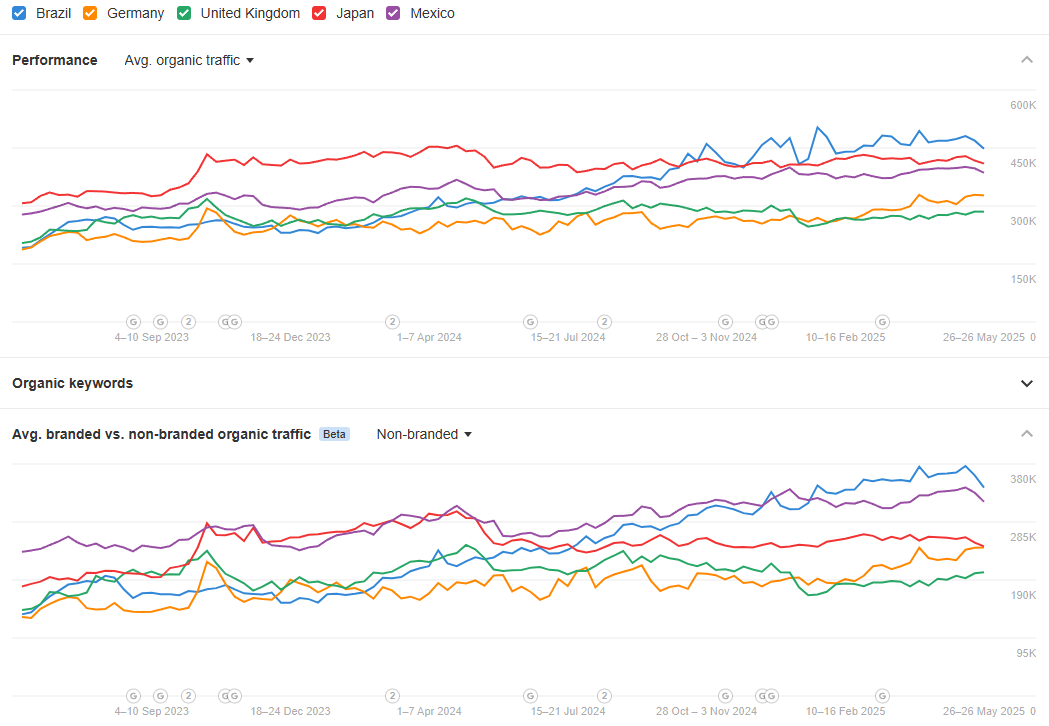 Image Credit: Kevin Indig
Image Credit: Kevin IndigA counter-example is this domain, which has too many country subdirectories.
For example, it has a subdirectory for /en and /en-us/. As you can see from the diverging traffic lines in the screenshot below, Google struggles to understand which subdirectory to rank at the top.
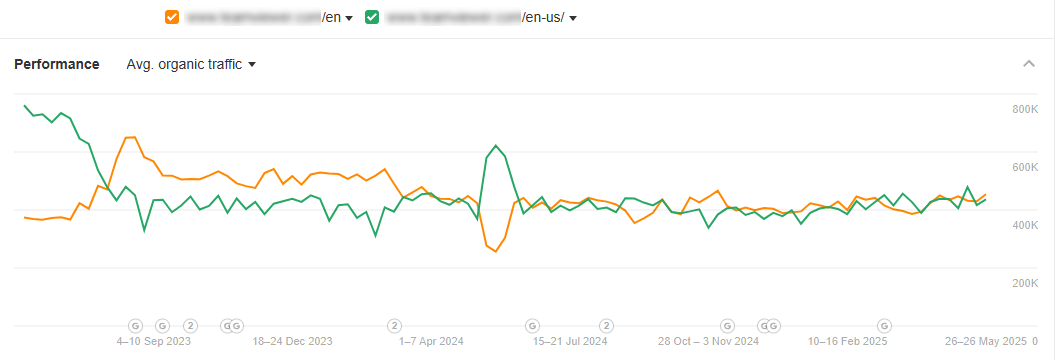 Image Credit: Kevin Indig
Image Credit: Kevin IndigWhen evaluating local conditions through the lens of proper, functional localization across your site, focus your attention on these key dimensions:
1. Regulatory, legal, and compliance conditions.
Certain markets present unique regulatory obligations where you’ll have to take specific actions. Here are a few examples:
- Indonesia & Vietnam: Require mandatory registration as an Electronic Systems Provider (PSE registration).
- Brazil: Demands a local Data Protection Officer (DPO); data residency requirements apply for regulated industries like financial services and healthcare.
- Censorship-heavy countries: Turkey, Iran, China – all necessitating special consideration for content restrictions and compliance.
2. Technical infrastructure and user context.
Tech constraints and habits shape recreation choices, speed expectations, and UX localization needs, like:
- Africa (Nigeria, Kenya, South Africa): Heavy reliance on lower-spec Android devices demands careful attention to page size and loading speed.
- Global date and format variations: U.S. format conventions (MM/DD/YYYY) differ significantly from many other locales, such as Germany (DD/MM/YYYY). Localization extends into numerical formatting and units as well.
The Problem
Many brands mistakenly treat localizing content as simply translating text into foreign languages (“word-for-word”).
But translation only handles basic information, ignoring deeper nuances around culture, emotion, humor, symbolism, taboos, and context.
There are several different methods/approaches to localization:
- Pure word-for-word translation: Good only for straightforward or legal texts (such as invoices, terms of service, or technical specs). Typically, only numbers, currencies, units, and basic SEO keywords are adapted.
- Localization of content: Adjusts copy, headlines, CTAs, imagery, emotional triggers, and metaphors for local cultures. Content conveys the same intent but resonates differently (“same meaning, new words”).
- Culturalization of content: Goes deeper still, changing narrative and visuals, adapting low-context vs. high-context communication styles (i.e., direct vs. indirect language), colors, symbolism, taboos – even altering the product or campaign concept itself.
- Co-creation (local original content): Fully tailored content created from the start by local experts – highest impact but highest effort and cost.
But most brands only focus on word-for-word translation or light localization of content. Many orgs miss out on investing in deeper localization, culturalization, or co-creation.
Why It Matters
If you focus only on word-for-word translation or light localization efforts, rather than doing the deeper work of cultivation of content and even co-creation, it can cause huge breaks in trust and/or missed conversion opportunities.
These real-world missteps show costly localization shortcuts in action:
- Pepsi translated “Brings you back to life” into Mandarin as “Brings your ancestors back from the grave.”
- HSBC’s “Assume Nothing” tagline became “Do Nothing” in certain markets, prompting expensive rebranding (£10 million).
- Electrolux U.S. advertised its vacuums as “Nothing sucks like an Electrolux” (harmless UK idiom, embarrassing in American slang).
- Gerber Baby Food jars depicted baby faces in West Africa, where labels typically showed product ingredients, alarming customers who believed they sold baby meat.
How To Solve It Clearly
- Prioritize localizing high-value hero/landing pages thoroughly and correctly.
- Engage native market experts to review copy, visuals, and creative.
- Adapt imagery, localized holidays, date formats, currency, and units.
- Perform new local keyword research using native SEO tools.
- Validate the cultural appropriateness of all local references before launch.
When evaluating local conditions through the lens of deep localization, focus your attention on these key dimensions:
1. Alphabetical and linguistic differences.
Pay attention to the localization work needed for non-Latin alphabets and scripts. Examples include:
- Japan.
- Israel.
- Middle East/Gulf Region (Saudi Arabia, UAE, Egypt).
Plus, your team should acknowledge and consider multilingual complexities.
India is an excellent example of this, with 22 official languages, and search behaviors in Hindi, Tamil, and Bengali significantly differ from English.
2. Alternative search engine landscapes.
Not every market is dominated by Google. Adapt SEO strategies for local search engine market share.
Here are a few instances to keep in mind where Google isn’t the primary search engine:
- South Korea: Naver (~55% market share).
- Russia and CIS region (RU, UA, KZ): Yandex (around 45% share).
- Czech Republic and Slovakia: Seznam (~15–25% of searches).
Applying thorough localization steps will avoid costly mistakes, preserve positive brand perception, and unlock organic reach in new markets effectively.
Our biggest SEO win at Shopify – ever – was domain unification.
In the summer of 2022, we combined all ccTLDs and language subdomains under the .com root directory and saw a +2x uplift in organic traffic.
Keep in mind, growth was incremental and not just due to adding more content to the domain.
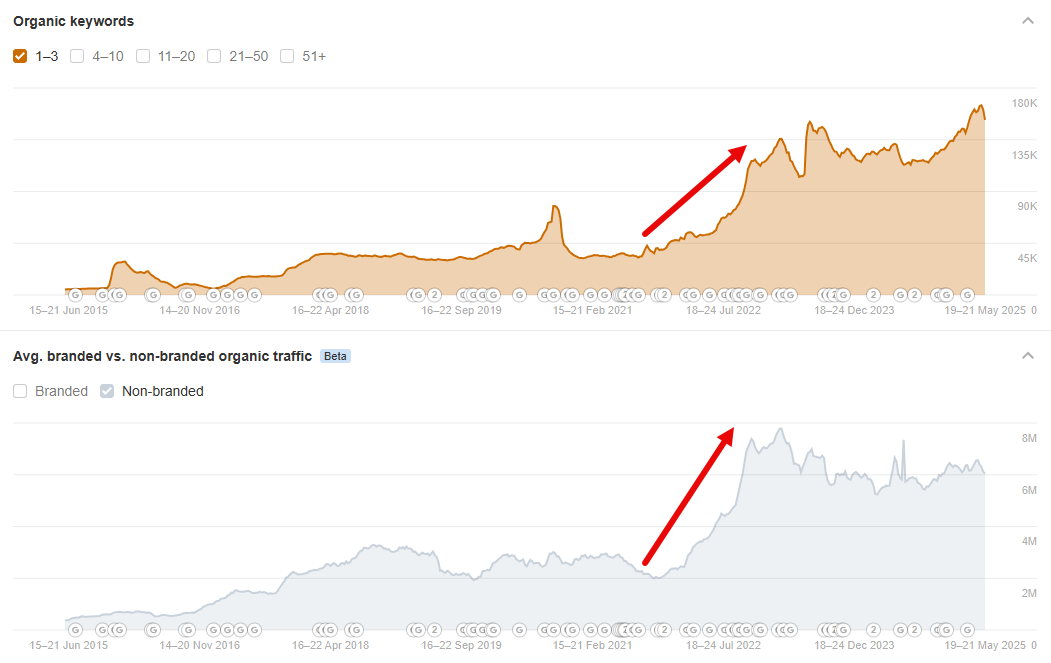 Image Credit: Kevin Indig
Image Credit: Kevin IndigInternational expansion can really be the growth lever you’re looking for, as long as you keep the following guidelines:
- Pick the right site architecture.
- Don’t forget critical technical SEO details.
- Structure your INTL SEO team right.
- Differentiate by business model.
1. Pick The Right Site Architecture
Subdomain vs. ccTLD vs. Subdirectory
If you know me, you know I’m a big proponent of subdirectories.
I mean, you can’t blame me after the success I’ve seen with it at Shopify.
So, to be crystal clear, there are advantages to each:
- ccTLDs are easy to recognize for users and lend themselves best for country-specific marketing campaigns.
- Subdomains come with clean separation of codebases and servers (and lower migration risk because the domain stays the same).
- Subdirectories combine the link and brand equity for all languages, incur no extra maintenance cost, and simplify reporting and monitoring.
From a purely SEO POV, I suggest you go with a subdirectory for languages.
Translating Slugs
A common question I get is whether to translate URL slugs.
There are strong pros and cons, which I will go into below.
But my recommendation is to keep the slug for markets that share the Latin alphabet and translate slugs for different alphabets (e.g., Japanese, Arabic).
Pros to translating URL slugs:
- Local-language terms in the slug can reinforce topical relevance and match query strings, giving a small ranking and CTR lift when the keyword is part of the URL snippet.
- Native-language URLs look familiar, are easier to read aloud or copy-paste, and signal that users are on the “right” version.
- When titles, headings, on-page copy, and slug are all in the same language, the page sends an unambiguous language signal.
- Shared links automatically carry meaningful anchor text (the slug) in the local language, which can help attract region-specific backlinks and improve social click-through.
Cons to translating URL slugs:
- Every new language demands a slug translation and QA. Any copy updates require synchronized redirects across locales.
- Changing a slug later (to fix a mistranslation or branding change) means 301s and a temporary performance dip; large-scale slug changes are expensive and error-prone.
- Non-ASCII characters must be UTF-8 encoded (%E6%97%A5%E6%9C%AC), making links look “ugly” in raw form and occasionally breaking older analytics, ad-tracking, or e-mail systems.
- Uniform path segmentation (“/product/123/”) is lost when each slug differs (“/produkt/123/”, “/producto/123/”). Dashboards and regex-based tracking need extra maintenance.
2. Don’t Forget Critical Technical Details
To account for the technical side of things, you must keep the following in mind:
- Have the correct hreflang setup in place. Don’t forget the self-referencing tag for every page.
- Create a GSC property and Bing Webmaster Tools account for every language/subdirectory. Configure language targeting.
- Add language-specific XML sitemaps.
- Use consistent language codes and canonical tags. Watch out for https vs. http and referencing the right language version of the domain.
- Translate schema text fields (name, description) and priceCurrency.
- Specify a fallback page and language with the x-default tag.
- Localize the schema for each language, especially Organization, Product, FAQ, BreadcrumbList, and priceCurrency.
- Use a CDN for fast page speed in every market. Consider local hosting or a CDN edge in countries where page speed is still slow.
- Test page speed from different locales and devices with Google PageSpeed tools or webpagetest.org to account for markets where most users have slow devices.
- Avoid automatic geo-redirects.
I will say, even with perfect technical optimization and localization, Google sometimes struggles to show the right URLs or even the domain in the right country.
I discuss some of the things you can do with Daan Aussems on LinkedIn:
- Add the country to the meta title.
- Use local case studies and authors.
- Localize images and videos.
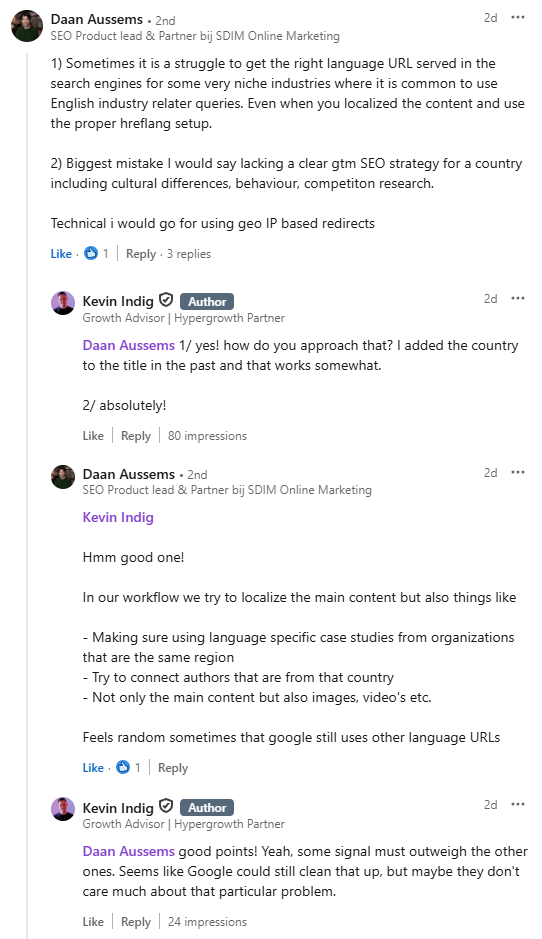 Image Credit: Kevin Indig
Image Credit: Kevin Indig3. Structure Your INTL SEO Team Right
When setting up your international SEO function, you’ll need to decide between two main structural approaches:
- A centralized SEO team.
- A centralized SEO team with regionally embedded specialists.
Choosing the right one depends on your organization’s resources, local market requirements, and the depth of localization you’ll pursue.
Option 1: Centralized SEO Team
In a centralized structure, one SEO team (typically in your home or core market) manages SEO across all international markets.
Pros:
- Greater consistency in strategy, reporting, and standards.
- Simplified internal communication and collaboration.
- Easier to manage a cohesive brand narrative and keyword strategy.
Cons:
- Lacking native insight might affect local keyword relevance.
- Greater risk of cultural blind spots and missing nuances.
- Depending extensively on translation/localization teams for accuracy.
When to pick this option:
Ideal if you’re early in the internationalization phase with limited internal resources or for situations where nuances between different regions aren’t highly sensitive.
Option 2: Centralized SEO Team + Regionally Embedded SEO Specialists
In this hybrid approach, you have one central strategy-setting team supported by local SEO specialists who are native to each target market.
A good middle ground might be a core (central) SEO team plus native speaker specialists dedicated to your highest-potential or highest-complexity markets.
Pros:
- Balance of control and autonomy – central strategy but local tactical execution.
- Ideal for keyword and content localization: Local specialists deeply understand culture and language nuances.
- Faster adjustments based on local market changes.
Cons:
- Higher overhead (staffing, coordination overhead, reporting structure complexity).
- Potential conflict if regional priorities don’t align perfectly with global strategy.
When to pick this option:
Perfectly suited for large sites with complicated localized strategies, high cultural sensitivity, significant growth goals in international markets, and sufficient internal resourcing.
Regardless of which team structure you choose, clarity around reporting lines is essential. A clear organizational structure for most successful global companies often includes:
- The overall SEO strategy (core global SEO) team typically reports to a head of growth or related executive.
- Regional specialists embedded in specific markets report either directly or “dotted-line” horizontally into the global SEO lead, who is under a gobal growth or marketing department.
- Regional content teams ideally report to a global head of brand & content or a similar branding/content position. Regional SEO specialists work horizontally as internal consultants/advisors. Their role involves keyword research, SEO recommendations, brief preparation, and ongoing performance analysis of regional performance.
This arrangement separates content production (managed by branding/content teams) and the optimization of that content (managed by SEO teams).
Successful international SEO workflows vary significantly by your business type.
Below are tailored recommendations clearly segmented by ecommerce and SaaS/digital product business models, since that makes up most of my readers here.
But if you’re in another industry and have questions about tailored SEO workflows or recommendations for your business type, drop your question to me via comment or mailbag (part of the premium subscription).
Ecommerce
Clearly communicate and optimize for regional purchasing expectations to increase trust and conversions:
- Localized product content: Translate and culturally adapt product titles, descriptions, specifications, visuals, alt attributes, and schema fields. Check that each element resonates meaningfully in your target market.
- Pricing and currency clarity: Display local currency by default based on the user’s location or preferences, and ensure prices reflect local market standards competitively.
- Checkout localization: Localize checkout fields, input validations, zip/postal fields, phone number structures, and date formats. User trust quickly erodes if a payment form feels foreign or confusing.
- Inventory and shipping transparency: Clearly communicate product availability and adjust your shipping timelines to reflect real conditions per market. If possible, offer intuitive region-aware dashboards that display stock availability locally. Use tables, calculators, or customizable widgets to guide users accurately on expected shipping speed and delivery charges.
- Flexible payment methods: Marketborne payment preferences vary regionally – clearly research and implement local standards:
- Latin America: Mercado Pago.
- China: Alipay, WeChat Pay.
- Europe (Netherlands): iDEAL, SEPA Direct Debit.
- Germany: Klarna, SOFORT.
- Japan/Korea: local banking transfer methods.
- Duties and tax transparency: Show clear explanations about VAT, duties, and customs charges. Surprise costs lead users to abandon purchase flows. You may leverage duty calculators or explicitly highlight applicable import taxes directly at checkout.
SaaS And Digital Products
For global SaaS/digital products, localized trust emerges not just from content, but also from user experience framing and region-specific nuance:
- Interface localization (website and app): Provide fully localized in-app interfaces, tooltips, messages, error dialogues, sub-menus, etc. Localization should seamlessly integrate with the overall UX flow, including subtle things like date formats, numbering conventions, and time zones.
- Comprehensive documentation localization: At a minimum, translate key onboarding materials, help documents, FAQs, and in-app tutorials. Tailored documentation improves UX drastically by removing language-based friction in complex tasks.
- Relevant regional thought leadership content: Adapt or create locally relevant content – if possible, base this content on specific region-based data or market insights. Share reports, studies, case studies, webinars, trend analyses, etc., highlighting local-specific usage narratives.
- Localized social proof and testimonials: Highlight customers, logos, reviews, or testimonials reflecting regionally recognized brands and clients; strengthens credibility and reduces “foreign brand skepticism.”
- Regional compliance and regulatory standards: Clearly map differences in regulatory compliance needs across markets; e.g., GDPR or Personal Information Protection Law (Japan), CCPA (California), electronic service provider regulations, accessibility standards, etc. Confirm you meet regional standards explicitly to minimize legal risk (and possible penalties).
I get this question a lot: When should I expand into an international SEO play?
Knowing when to move beyond your core domestic market can be just as critical as knowing how.
While growing slowly within your home market may feel safer or easier, you’re potentially leaving significant growth untapped.
At the same time, expanding prematurely into international markets might stretch resources thin and dilute your initial peak-market potential.
So, how should you discern when the time is ripe to expand internationally?
In some scenarios, opting to capture market share overseas before competing in a saturated domestic market can even become a strategic advantage, called counter-positioning.
Companies can rapidly establish strongholds in regions lacking dominant incumbents, leverage brand equity abroad first, and only then turn toward challenging larger opponents in the United States or more mature markets.
An example of this approach is StuDocu, a European-born study content-sharing site, versus the initially U.S.-oriented ed-tech giant Course Hero.
Rather than directly challenging Course Hero head-on within saturated American campuses, StuDocu methodically expanded into underserved European, Asian, Latin American, and Australian universities – regions that Course Hero gave lower priority.
This strategic “root growth” in international territories allowed StuDocu to scale rapidly, create a vast global user base, create defensible moats locally, and eventually build the brand equity necessary to mount an effective push into highly competitive markets, including the United States.
There are a few clear criteria every global growth leader should closely examine to inform their strategic expansion timing:
1. Traffic Opportunity (Search Demand)
Before investing heavily, ensure there’s a substantial unmet organic and paid search opportunity around your core offering and targeted keywords.
2. Brand Awareness Signals
Examine your analytics and search queries: Do you already get meaningful visits or searches from the target country? Strong brand indicators can accelerate your market entry.
Quantify current organic visits and branded keywords from those markets despite not actively targeting or marketing to them.
For example, if your analytics reveal repeated organic traffic from Germany with users searching explicitly for your company name or key terms, it signals existing awareness, early-adopter userbase, or even offline word-of-mouth that deserves deeper attention.
3. Competitive Dynamics
Evaluate how mature each prospective target market currently is and understand the competitive landscape deeply:
- Who are the local or international incumbents dominating this particular market niche currently?
- How strong are those websites from both a content and SEO quality standpoint?
- Consider prioritizing up-and-coming markets or regions that are less penetrated by your primary competitors.
4. Market Size And Financial Opportunity
Validate economic logic through a comprehensive market-sizing exercise and initial return-on-investment (ROI) forecasts.
Markets vary broadly by total addressable market (TAM). Scrutinize total market population, GDP per capita, digital connectivity/internet penetration, and mobile saturation data (World Bank, Euromonitor, Statista).
5. Feasibility (Non-SEO Factors)
Even leading SEO and financial criteria scores can be blocked or undermined by inefficient operational, legal, or team-related feasibility realities towards a market.
Explicitly identify:
- Legal/regulatory barriers: data protection (GDPR, LGPD specifics), product registration, certifications, licensing, and upfront legal costs.
- Cultural nuances that affect product viability: Can product-market fit freeze or vanish redesigns that differ significantly internationally? Localization realities around payment, checkout, and currency complexities?
- Shipment and fulfillment chains: Can product/service offer seamless local user experiences with reliable shipping speeds, payment providers, customer support language, and channels?
- Internal or partner resourcing: Do current or justifiable investment resources (teams, budget, or executive priorities) align smoothly with engaged regional requirements?
I want to share a few other tools I’ve used over the years.
To evaluate the market as a whole:
- Market Finder: Evaluates your business categories against the total number of searches (search volume), average disposable income, ease of doing business, and the size of the recommended Google Ad bid.
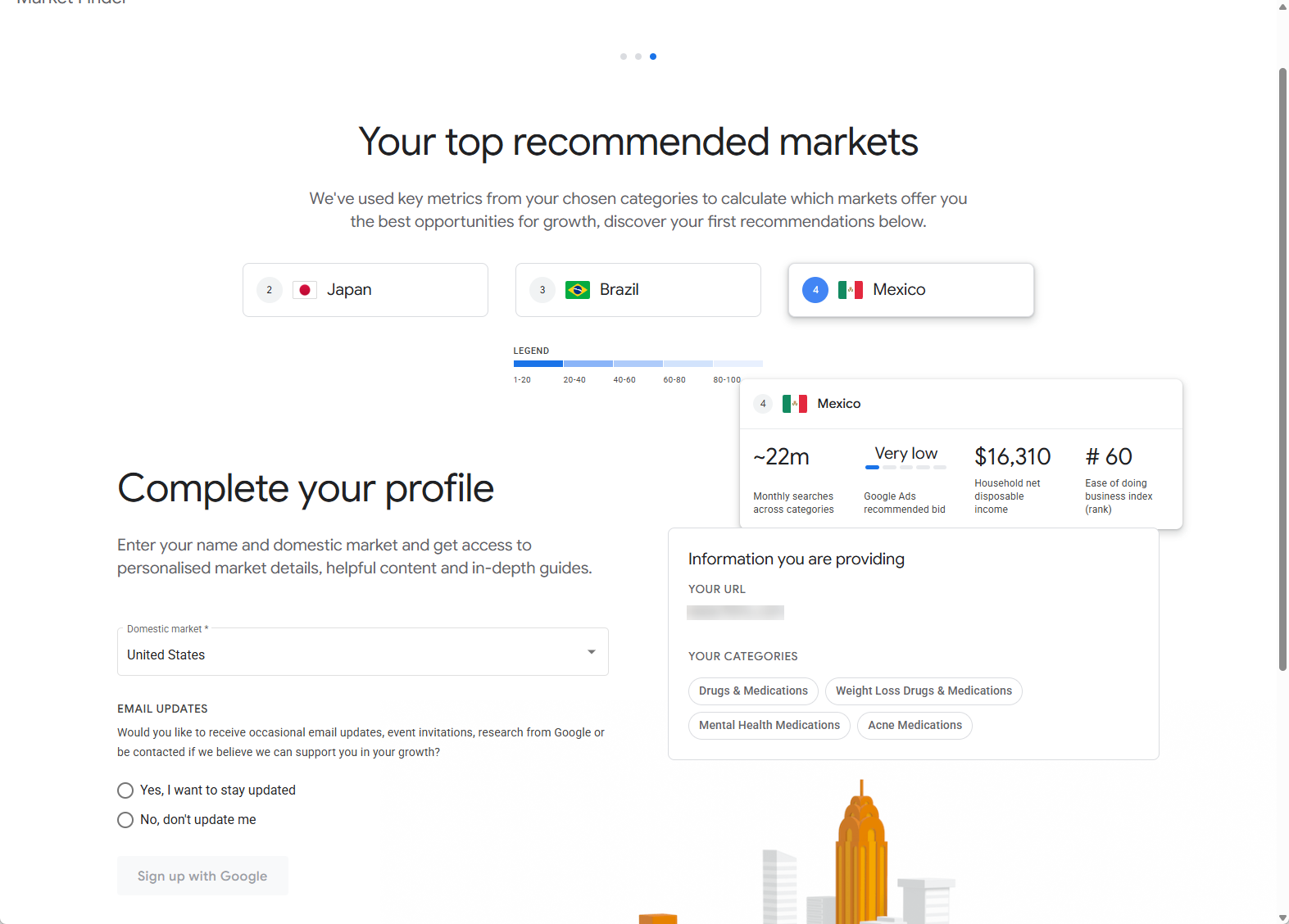 Image Credit: Kevin Indig
Image Credit: Kevin IndigTo evaluate traffic potential and competitive saturation:
- Similarweb Market Intelligence: Estimates monthly visits, engagement, and top referrers for any country/industry.
- Semrush Market Explorer: Overlays search volume, paid spend, and audience demographics per market.
- Ahrefs “Traffic Potential” + “Top Countries” reports: Quick read on how much of a keyword set sits outside your home region.
- Sistrix Visibility Index by country: Reveals incumbent SERP strength; great for spotting “easy” regions.
- Google Keyword Planner (but switch location filters): Still the cleanest directional gauge for non-English SERPs.
To evaluate purchasing power and market potential:
- World Bank’s DataBank: GDP, internet penetration, card adoption, all exportable.
- Euromonitor Passport: Consumer-spending forecasts across 100+ categories.
- Statista Global Consumer Survey: Payment methods, brand awareness, category usage by country.
Technical SEO tools for international SEO:
- Hreflang testers.
- General auditing tools.
- Screaming Frog
- Semrush Site Audit
- Ahrefs Site Audit
- CDNs:
1 Introducing the Airbnb 2021 Winter Release: 50+ upgrades and innovations across our entire service
Featured Image: Paulo Bobita/Search Engine Journal




